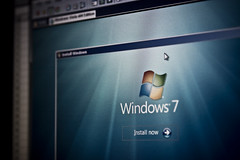For the past few months, we've had the opportunity to preview the "new" Microsoft Windows OS (operating system). This successor to the much maligned Windows Vista has been available for download from the Microsoft website, so we decided to give it a spin. Windows 7, as it is known, is free to use until June 2010 - after that, you have to pony up to Microsoft, or revert back to your previous OS (Vista, in our case). The download, and more information, is available here.
If you'd like to try the free version, it might be best to hurry. Microsoft reports the release candidate will be available "at least" until July 2009 - after that, who knows?
The Windows 7 installation was pretty easy, even for a computer illiterate like me. You first download what is known as an ISO image file from Microsoft. Next you have to burn the file to DVD; make sure your computer can burn DVDs and that it is capable of burning ISO images (there are several free programs that burn ISO files, if your computer is not supplied with this capability). Microsoft supplies you with a "key" to activate your Windows 7 installation, so make sure you print the key code out and store it in a safe place.
Okay, now you have your two most important ingredients: a Windows 7 installation disc and the key code to validate it. But before you pop that disc into your DVD player, you should take care of a few preliminaries.
First you should read the Windows 7 download section and verify you have the minimum RAM and hard-disc memory to successfully operate your new OS. Make sure your download corresponds to your computer's architecture, either 32 or 64 bit. Then you need to locate your current system's restore disc (or make one if it wasn't supplied with your computer); this will enable you to restore your computer in case you decide Windows 7 is not to your liking, or your installation isn't successful. In addition, it would be prudent to back up important files, such as documents and pictures, to disc for later retrieval.
The actual Windows 7 installation took about 20 minutes. Simply place the DVD you created in the player, restart your computer, and follow the onscreen prompts. Your computer will automatically start and stop a few times, and then you will see a new screen that looks like this:

It didn't take us long at all to get Windows 7 set up for our personal preferences. Anyone familiar with Windows Vista will have no problem navigating the start menu, icons, and file system. However, you should be aware that the Windows 7 Release Candidate comes with no bundled software (other than the usual Internet Explorer). The first thing I did, after finishing the installation, was download the Firefox browser, Open Office Suite, and AVG Antivirus, all of which are free. The included Windows Firewall and Windows Defender (anti-spyware) seem to be quite sufficient.
All in all, Windows 7 seems to be a solid system - what Vista should have been.
UPDATE - 7/16/09
Microsoft will continue to offer downloads of the Windows 7 Release Candidate until August 20, 2009. You can get your activation key, installation instructions, and the OS itself at the download page. Starting October 22 it will be offered in new PCs and on store shelves.
Related articles by Zemanta
Microsoft announces free antivirus, limited public beta (arstechnica.com)
Microsoft ditches Windows 7 E plans (theregister.co.uk)

![Reblog this post [with Zemanta]](http://img.zemanta.com/reblog_e.png?x-id=0c4886ca-8afe-46ad-99a4-90566eff6de2)
No comments:
Post a Comment